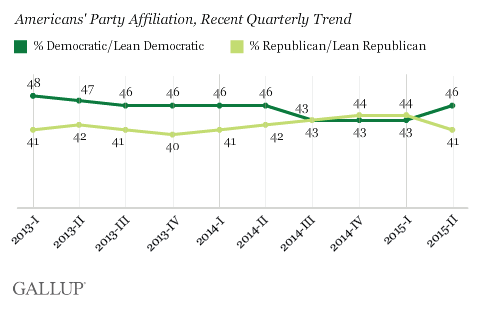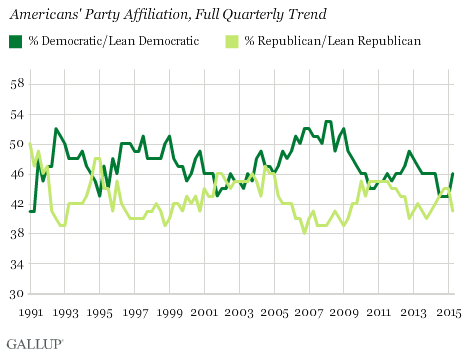Story Highlights
- Democrats regain edge in party affiliation, 46% to 41%
- Parties had been even in the prior three quarters
- Democrats typically have an edge
PRINCETON, N.J. -- In the second quarter of 2015, Democrats regained an advantage over Republicans in terms of Americans' party affiliation. A total of 46% of Americans identified as Democrats (30%) or said they are independents who lean toward the Democratic Party (16%), while 41% identified as Republicans (25%) or leaned Republican (16%). The two parties were generally even during the previous three quarters, including the fourth quarter of 2014, when the midterm elections took place.

Republicans have seemingly lost the momentum they had going into last fall's elections, which saw them make significant gains in congressional seats, including taking partisan control of the Senate. After those victories, Americans' overall opinions of the Democratic Party worsened while the public grew slightly more positive toward the GOP.
Republicans were able to maintain an even footing with Democrats through the first quarter of this year, but in the second quarter, the percentage of Democratic identifiers and leaners increased by three percentage points while the percentage of Republican identifiers and leaners decreased by three points. As a result, Democrats are now back to where they were in 2013 and early 2014.
The results are based on aggregated data from three Gallup surveys conducted in the second quarter. Gallup's Daily tracking survey also shows a five-point Democratic advantage in party affiliation during the second quarter.
Democrats Usually Lead in Party Affiliation
Gallup has consistently measured Americans' party identification and -- for those who initially identify as independents -- partisan leanings since 1991. During those 24 years, Democrats have typically held an edge in party affiliation.
There have been a few instances in which Republicans held at least a slight edge for multiple quarters. These include:
- in 1991, after the U.S. victory in the first Persian Gulf War, under Republican President George H.W. Bush
- in late 1994 and early 1995, after the Republican victories in the midterm elections that gave the party control of both houses of Congress for the first time in four decades
- in late 2001 and early 2002, when Americans' support for elected officials including Republican president George W. Bush surged after the Sept. 11 terrorist attacks
At other times, Republicans and Democrats have been relatively even for multiple quarters. Most of these have occurred late in election years in which Republicans fared well, including the 2004 presidential election and the 2002, 2010 and 2014 midterm elections.

As is true now, Republicans have in the past failed to sustain gains in party affiliation for long. And as has occurred multiple times in the past, Democrats have returned to having healthy advantages in party affiliation in the quarters and years that followed prior Republican strong points, such as in 1992-1993, 1996-2000 and 2005-2009.
Implications
Republicans have lost ground versus Democrats over the last three months in terms of the percentage of Americans who align with each party, essentially resetting the political map to what it had been in 2013 and early 2014, and putting the Democrats in a favorable political position as the 2016 campaign is getting underway.
Democratic gains in party affiliation may be partly linked to more positive views of President Barack Obama, whose job approval ratings were near his personal lows last fall but have recovered, perhaps related to low unemployment, lower gas prices than a year ago and an easing of some of the international challenges that faced the U.S., such as the Ukraine-Russia situation.
The recent changes in party affiliation may also reflect Americans' fading memory of the GOP's electoral successes in the 2014 midterm elections that made it the majority party in the Senate while increasing its majority in the House of Representatives. This follows the pattern that occurred after the 1994, 2002 and 2010 elections, when stronger Republican positioning after those elections proved short-lived.
And although Obama and the Republican majority in Congress remain a major focus of the political news coverage, attention is increasingly turning to the 2016 presidential campaign. Here Democrats may be benefiting from having a well-known and relatively popular front-running candidate in Hillary Clinton, which paints a contrast to the large, fractured and generally less well-known field of Republican presidential candidates.
Survey Methods
Results for this Gallup poll are based on telephone interviews conducted April-June 2015, with a random sample of 3,566 adults, aged 18 and older, living in all 50 U.S. states and the District of Columbia. For results based on the total sample of national adults, the margin of sampling error is ±2 percentage points at the 95% confidence level. All reported margins of sampling error include computed design effects for weighting.
Each sample of national adults includes a minimum quota of 50% cellphone respondents and 50% landline respondents, with additional minimum quotas by time zone within region. Landline and cellular telephone numbers are selected using random-digit-dial methods.
Learn more about how Gallup Poll Social Series works.

